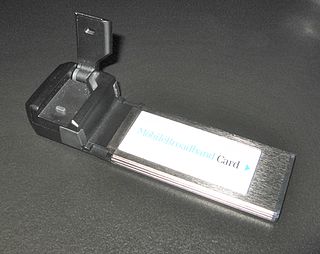Related Research Articles

Handsfree is an adjective describing equipment that can be used without the use of hands or, in a wider sense, equipment which needs only limited use of hands, or for which the controls are positioned so that the hand can occupy themselves with another task without needing to hunt far afield for the controls.

Internet access is a facility or service that provides connectivity for a computer, a computer network, or other network device to the Internet, and for individuals or organizations to access or use applications such as email and the World Wide Web. Internet access is offered for sale by an international hierarchy of Internet service providers (ISPs) using various networking technologies. At the retail level, many organizations, including municipal entities, also provide cost-free access to the general public.
4G is the fourth generation of broadband cellular network technology, succeeding 3G and preceding 5G. A 4G system must provide capabilities defined by ITU in IMT Advanced. Potential and current applications include amended mobile web access, IP telephony, gaming services, high-definition mobile TV, video conferencing, and 3D television.

Mobile computing is human–computer interaction in which a computer is expected to be transported during normal usage and allow for transmission of data, which can include voice and video transmissions. Mobile computing involves mobile communication, mobile hardware, and mobile software. Communication issues include ad hoc networks and infrastructure networks as well as communication properties, protocols, data formats, and concrete technologies. Hardware includes mobile devices or device components. Mobile software deals with the characteristics and requirements of mobile applications.

Telematics is an interdisciplinary field encompassing telecommunications, vehicular technologies, electrical engineering, and computer science. Telematics can involve any of the following:

Evolution-Data Optimized is a telecommunications standard for the wireless transmission of data through radio signals, typically for broadband Internet access. EV-DO is an evolution of the CDMA2000 (IS-2000) standard which supports high data rates and can be deployed alongside a wireless carrier's voice services. It uses advanced multiplexing techniques including code-division multiple access (CDMA) as well as time-division multiplexing (TDM) to maximize throughput. It is a part of the CDMA2000 family of standards and has been adopted by many mobile phone service providers around the world particularly those previously employing CDMA networks. It is also used on the Globalstar satellite phone network.

OnStar Corporation is a subsidiary of General Motors that provides subscription-based communications, in-vehicle security, emergency services, turn-by-turn navigation, and remote diagnostics systems throughout the United States, Canada, China, Mexico, Europe, Brazil, Colombia, Argentina and the Gulf Cooperation Council countries.

The history of mobile phones covers mobile communication devices that connect wirelessly to the public switched telephone network.

A mobile phone feature is a capability, service, or application that a mobile phone offers to its users. Mobile phones are often referred to as feature phones, and offer basic telephony. Handsets with more advanced computing ability through the use of native code try to differentiate their own products by implementing additional functions to make them more attractive to consumers. This has led to great innovation in mobile phone development over the past 20 years.
Wi-Fi calling refers to mobile phone voice calls and data that are made over IP networks using Wi-Fi, instead of the cell towers provided by cellular networks. Using this feature, compatible handsets are able to route regular cellular calls through a wireless LAN (Wi-Fi) network with broadband Internet, while seamlessly change connections between the two where necessary. This feature makes use of the Generic Access Network (GAN) protocol, also known as Unlicensed Mobile Access (UMA).

Sierra Wireless is a Canadian multinational wireless communications equipment designer, manufacturer and services provider headquartered in Richmond, British Columbia, Canada. It also maintains offices and operations in the United States, Korea, Japan, Taiwan, India, France, Australia and New Zealand.

Mobile broadband is the marketing term for wireless Internet access via mobile networks. Access to the network can be made through a portable modem, wireless modem, or a tablet/smartphone or other mobile device. The first wireless Internet access became available in 1991 as part of the second generation (2G) of mobile phone technology. Higher speeds became available in 2001 and 2006 as part of the third (3G) and fourth (4G) generations. In 2011, 90% of the world's population lived in areas with 2G coverage, while 45% lived in areas with 2G and 3G coverage. Mobile broadband uses the spectrum of 225 MHz to 3700 MHz.
WiTricity Corporation is an American wireless charging technology company based in Watertown, Massachusetts. The Massachusetts Institute of Technology (MIT) spin-off was founded by professor Marin Soljačić in 2007. WiTricity technology allows wireless power transfer over distance via magnetic resonance and the company licenses technology and reference designs for wireless electrical vehicle (EV) charging as well as consumer products such as laptops, mobile phones and televisions.
The 3GPP has defined the Voice Call Continuity (VCC) specifications in order to describe how a voice call can be persisted, as a mobile phone moves between circuit switched and packet switched radio domains.
Monsoon Multimedia was a company that manufactured, developed and sold video streaming and place-shifting devices that allowed consumers to view and control live television on PCs connected to a local (home) network or remotely from a broadband-connected PC or mobile phone. It was one of 5 major transformations initiated by Prabhat Jain, a Silicon Valley entrepreneur with 5 undergraduate and post graduate engineering degrees from Cal Berkeley and Univ of Vienna, Austria. On the even of Cisco acquiring Monsoon in 2017, EchoStar, the new parent of Sling sued Monsoon for patent infringement, having obtained confidential information about the date of the acquisition by Cisco from a Monsoon employee under murky circumstances. Monsoon settled the lawsuit by agreeing not to sell its products in the USA simply because it did not have the legal funds to fight mighty Echostar's legal maneuvers. EchoStar thus successfully removed its only competitor from the market place. This meant Monsoon's death knell.

Lexus Link, launched October, 2000, is a subscription-based safety and security service from Lexus. It has been offered as a factory-installed option, available on certain Lexus models, offering call-center-based telematics services to owners with equipped vehicles in the United States and Canada. The second-generation Lexus Link system utilizes a dedicated cellular phone, Global Positioning Satellite (GPS) technology and 24-hour live-operator support. In 2009, an expanded system with added functionality, Lexus Enform with Safety Connect, succeeded Lexus Link.

A mobile phone is a portable telephone that can make and receive calls over a radio frequency link while the user is moving within a telephone service area, as opposed to a fixed-location phone. The radio frequency link establishes a connection to the switching systems of a mobile phone operator, which provides access to the public switched telephone network (PSTN). Modern mobile telephone services use a cellular network architecture and therefore mobile telephones are called cellphones in North America. In addition to telephony, digital mobile phones support a variety of other services, such as text messaging, multimedia messaging, email, Internet access, short-range wireless communications, satellite access, business applications, payments, multimedia playback and streaming, digital photography, and video games. Mobile phones offering only basic capabilities are known as feature phones ; mobile phones which offer greatly advanced computing capabilities are referred to as smartphones.

Mobile technology is the technology used for cellular communication. Mobile technology has evolved rapidly over the past few years. Since the start of this millennium, a standard mobile device has gone from being no more than a simple two-way pager to being a mobile phone, GPS navigation device, an embedded web browser and instant messaging client, and a handheld gaming console. Many experts believe that the future of computer technology rests in mobile computing with wireless networking. Mobile computing by way of tablet computers is becoming more popular. Tablets are available on the 3G and 4G networks.
A connected car is a car that can communicate bidirectionally with other systems outside of the car. This connectivity can be used to provide services to passengers or to support or enhance self-driving functionality. For safety-critical applications, it is anticipated that cars will also be connected using dedicated short-range communications (DSRC) or cellular radios, operating in the FCC-granted 5.9 GHz band with very low latency.
RF CMOS is a metal–oxide–semiconductor (MOS) integrated circuit (IC) technology that integrates radio-frequency (RF), analog and digital electronics on a mixed-signal CMOS RF circuit chip. It is widely used in modern wireless telecommunications, such as cellular networks, Bluetooth, Wi-Fi, GPS receivers, broadcasting, vehicular communication systems, and the radio transceivers in all modern mobile phones and wireless networking devices. RF CMOS technology was pioneered by Pakistani engineer Asad Ali Abidi at UCLA during the late 1980s to early 1990s, and helped bring about the wireless revolution with the introduction of digital signal processing in wireless communications. The development and design of RF CMOS devices was enabled by van der Ziel's FET RF noise model, which was published in the early 1960s and remained largely forgotten until the 1990s.
References
- ↑ IEEE 1616 MVEDR
- ↑ Dashtop Sprawl
- ↑ "Mobile WiMAX" IEEE 802.16e-2005
- ↑ "NXTComm Show". Archived from the original on 2007-08-31. Retrieved 2007-12-05.
- ↑ "NXTComm Show". Archived from the original on 2007-08-31. Retrieved 2007-12-05.
- ↑ New York may ban iPods while crossing street
- ↑ Sony's battery recall
- ↑ "FCC 700MHz Band Auction". Archived from the original on 2013-04-13. Retrieved 2007-12-02.
- ↑ Beating Congestion with Mobiles
- ↑ Real Time Rome
- ↑ "Rethinking Traffic Congestion" (PDF). Archived from the original (PDF) on 2007-09-30. Retrieved 2007-07-29.
- ↑ UCLA Newsroom: Taking It to the Streets: UCLA Scientists Seek to Turn Cars Into a Mobile Communications Network
- ↑ JITeCGO
- ↑ "Mobile Ticketing". Archived from the original on 2008-02-06. Retrieved 2007-12-02.
- ↑ Information Week: Paperless Boarding Pass Program Kicks Off
- ↑ "Real-time fleet GPS tracking". Archived from the original on 2009-06-25. Retrieved 2009-06-17.
- ↑ Windowns Mobile for Automotive 1.0
- ↑ "Popular Mechanics". Archived from the original on 2007-11-23. Retrieved 2007-12-02.